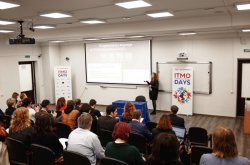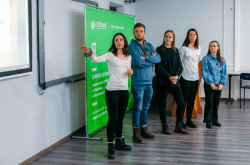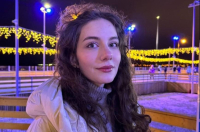What is the field that Gomel State University and ITMO University cooperate on?
Gomel State University is a classical university that trains students in traditional professions from law to engineering; the main cooperation area is physics and engineering, mainly between our“Physics of wave processes” laboratory and the Center of Nanophotonics and Metamaterials at ITMO University. Now we are working on metamaterial research and developing antennas based on spiral elements. The center of nanophotonics and metamaterials, in my opinion, has one of the most competent scientific groups in this field. Researchers from our Physics Faculty have also achieved international recognition in the field of metamaterial research and creation. They have been published in Physical Review X and in Physical Review B, which are reputable international journals with a high impact factor. Moreover, the researchers of both our universities have joint publications, including one on the study of spiral bifilar antennas with circular polarization of directional antennas based on spiral elements. We have a laboratory that deals with spiral elements in metamaterials.
The staff of the Center for Nanophotonics and Metamaterials are assisting the Belarusian counterparts in updating the anechoic chamber. Such chambers absorb and block any electromagnetic radiation, which is important and useful in carrying out experiments where only the radiation and not its reflection needs to be measured. We also agreed that ITMO University will grant us access to the High Frequency Structural Simulator program server, which will make it possible for us to create 3D electromagnetic field models using finite elements. Earlier we had access granted by Aalto University (Finland).
What about academic exchange and conferences?

We have been working with Pavel Belov’s group, he is the head of the Center of Nanophotonics and Metamaterials, for more than 15 years. During this time, we organized many internships and shared our experience, which resulted in joint articles. During 2014-2016 we held a special project, which allowed five of our students to get a Master’s degree at ITMO University while also getting a degree at our university.
Recently, Professor Andrei Lavrinenko one of the researchers at the Center for Nanophotonics and Metamaterials, head of the metamaterial team of the Technical University of Denmark gave a series of lectures in the field of theoretical studies of metamaterials. In October 2018 Stanislav Glybovski from ITMO University, will come to Gomel with a course of lectures. We have also hosted four finals of the Internet Olympiad in Physics held by ITMO University and Saint Petersburg State University. Last year, our university together with ITMO University participated in the organization of the first international youth conference “Information Technologies and Communication Technologies: Modern Achievements” at the Astrakhan State Technical University, which will be held again this year.
What do you think unites the scientists of our two universities in terms of their work?

I don’t see any fundamental differences in our approaches to work in the field of natural sciences and technology. We have similar programs taught in both English and Russian and the employees share a common mentality. In general, I'm not inclined to divide science into Russian, Belarusian, Polish, Lithuanian, or any other. If someone is involved in science, it doesn’t matter where they are. Our students study in Japan, Finland, Sweden and Switzerland and then return to Belarus and apply their knowledge here. At the same time, we can train students who are able to contribute to science on an international level. Any laboratory in any country has its strengths and downsides.
It may seem, however, that it is better to cooperate with European or American universities than with those in the CIS member-states?
We should not belittle our scientific achievements. Gomel State University, for example, cooperates with 130 universities; 80 of them being Russian. We have joint Master’s programs with National Research University of Electronic Technology and Kursk Academy of State and Municipal Service. In addition to ITMO University, we have established close scientific cooperation with the Rzhanov Institute of Semiconductor Physics. A group of physicians is working there under the guidance of Victor Prinz with the first nanolithography imprint machine for nanostructures manufacturing in CIS. In Gomel, we investigate these structures theoretically, simulate them, fabricate them for the microwave range and optimize the element arrangement, so that we can carry out expensive experiments on the study and fabrication of structures for the terahertz range in the laboratory of Victor Prinz. I do not know of any European groups where such experiments are conducted. Moreover, our Theoretical Physics Department is cooperating with the Joint Institute for Nuclear Research and together we have held international schools of microworld physics for undergraduates, PhD students and young scientists for more than 20 years in Gomel. We are also involved in various projects, including the NICA acceleration complex construction, which will be used to study strong interactions between elementary particles and other aspects of theoretical physics.

Everything depends on the task and scale of the project; there is no difference in where the laboratory is located if it suits you strategically. A joint Belarusian-Polish laboratory is working in our university, which won the TransFerr project grant last year (TRANSIT metal oxides with metastable phases: a way to ward superior FERRoic properties) within the framework of the EU grant program Horizon 2020. In this project, we will synthesize sol-gel by the nanopowder method and thin films consisting of transition element oxides and possessing magnetic properties. The international Chinese-Belarusian scientific laboratory on vacuum-plasma technologies at our university has skills in complex composition forming coatings based on carbon and metal nitrides, and we have established close cooperation in this field with the Nanjing University of Science and Technology in China.
Which practices would you like learn in St. Petersburg universities and which would you like to share?
I would rather learn how to attract talented students in engineering. ITMO University attracts the best applicants in physics and IT. We have no particular problems with applications to engineering departments but the competition in the humanities is much stronger. The point is that Belarusian pupils are scared of physics, so to say. Companies are very often facing difficulties in finding a good coder or engineer. Therefore, a lot is done at the state level to turn Belarus into a “digital” country. In December last year a decree was signed that creates unprecedented conditions for the IT industry and gives a competitive advantage to the country in creating the digital economy of the 21st century.

For example, the Gomel Technopark has been created to stimulate IT companies development throughout the country and can be used from anywhere in Belarus. The Park’s product export (mainly software) exceeded $1 billion in 2017 and the product model is added to the service one right now. I should note that our graduates are the main employees of Gomel subdivisions of such companies as EPAM-Systems and the IBA Group. By the way, I came to St. Petersburg on a plane decorated with the World of Tanks logo, a game that was created in Belarus.
You have already said that science has no boundaries, but is it still better when graduates stay in their home universities, especially with the staff shortage that you’ve mentioned?
Of course, we are striving to ensure that the most talented students study in Belarusian universities in order to remain working in them. However, modern students are pragmatic and we do not live behind the iron curtain. Everyone can choose their own way. Many of our graduates, having gained experience in other countries, return to Belarus to share this experience and act as mentors. In Belarus we also have a practice of distributing the scholarship students in enterprises and organizations so that they get a start for their career. Sometimes it is seen as a drawback. But on the other hand, having the labour market competition in mind, we can say that it is an advantage for students who have no practical experience, an opportunity to learn the industry of their country and contribute to its development. Of course, if students start working before graduation we try to save their workplace. It is necessary to raise children’s awareness about physics and engineering careers in schools, which our university is also involved in. For example, we were the first in Belarus to hold “University Saturdays”, when pupils can visit the university, see how laboratories work and listen to our lectures. Then this practice spread all over the country. We are doing a lot to attract the best applicants and judging by the incoming subject Olympiad winners, we are succeeding in it.
Translated by Pavel Vorobyev





